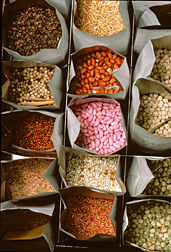This page has been archived and is being provided for reference purposes only. The page is no longer being updated, and therefore, links on the page may be invalid.
|
|
|
|
ARS Preserves Plants and Animals for Future Needs
By Kim KaplanMay 15, 2009
When the Russian wheat aphid spread to the United States in 1986, all of the country's commercial wheat was susceptible to it.
To find resistance to this insect that cost American wheat and barley farmers billions of dollars in losses, Agricultural Research Service (ARS) scientists turned to the agency's National Small Grains Collection in Aberdeen, Idaho, to screen more than 30,000 wheat accessions and 24,000 barley accessions for resistance. The collection is part of ARS' National Plant Germplasm System (NPGS).
ARS researchers identified more than 300 resistant wheat germplasm accessions and 40 promising barley lines as potential sources of resistance genes, mostly from the ARS germplasm collection. Breeders began a "crash program" using this germplasm to develop new varieties, and the crisis was averted.
The NPGS preserves thousands of agronomically important plants and their relatives in working collections around the country. Each collection concentrates on specific types of plants. In addition, the National Center for Genetic Resources Preservation (NCGRP) in Fort Collins, Colo., keeps plant germplasm in long-term cryogenic storage.
The NPGS is an important heritage of plant diversity. It is also a stockroom for tools to deal with problems like the mutation of a pathogen, explains David Ellis, a curator and plant physiologist at NCGRP.
Researchers from all over the world turn to the NPGS to solve disease problems and also to expand plants' drought and temperature tolerance, adapt plants to new growing conditions, and make them more productive, nutritious, durable, or simply better tasting. The NPGS distributed more than 182,800 plant samples worldwide in 2008.
Germplasm preservation is not an action that can wait until new genes are needed. Global climate change, loss of habitats, and even war and political instability threaten genetic variation in agriculture and in the wild. Pathogens and pests continue to evolve. Protecting as wide an array as possible of crop varieties and their wild relatives is the best insurance policy, because it's impossible to tell ahead of time just what genes a plant may offer that may one day be needed.
ARS is the principal intramural scientific research agency in the U.S. Department of Agriculture.

